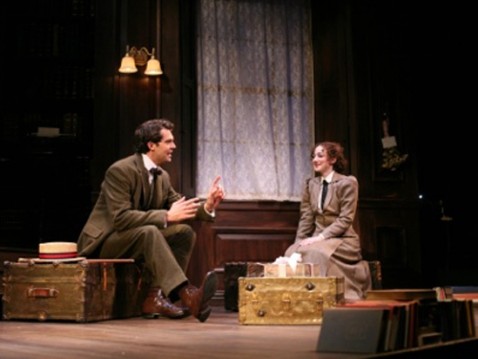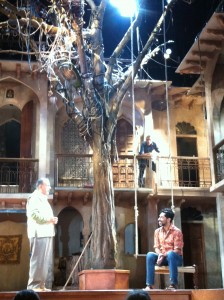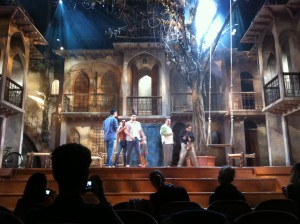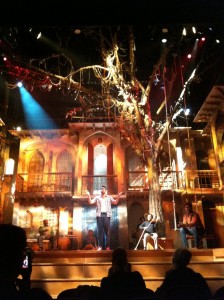Episode 2. Here be spoilers. I will start by saying that I was genuinely frightened by this episode; watching with the curtains closed. “Nothing can physically harm you”, intones character Katie to our protagonist Cooper, an American man travelling the world to escape problems at home. But she can’t know that, not for certain. Accidents happen. The simple power of being alone in the dark working against every rational instinct you have that everything’s fine really is deployed here superbly. Skipping over the finer plot details, when the plot twist is revealed, it’s good. But there’s more; this is no Bobby Ewing in the shower moment. Reality falls away as we realise we’ve been duped more than once along the way here. I foresee irritation on the part of some viewers, but with clarity perhaps a grudging admiration might develop. It’s where I am now.
TV review: Nosedive (Black Mirror)
So it’s here. Netflix gives us Charlie Brooker’s glimpses into the near future – one exception – in all-new BLACK MIRROR, the first episodes since the 2014 feature-length special.
NOSEDIVE
When Netflix announced it had commissioned twelve new episodes, the Twittersphere leapt in to action and groupthought the notion that the show, a gritty piece of navel-gazing exposé, would become “Americanised”, with all the Trump-electing horror that could bring. I report that this is not the case. The team of writer Charlie Brooker and executive producer Annabel Jones, a longtime collaborator with fine results, endures with excellent results.
NOSEDIVE is, however, set in America. So far, it seems to me to be set the closest to the present day of all the previous episodes. There are electric cars but they’re not driverless. People still hold mobile phones; they aren’t embedded under our skin. People use video calling rather than teleportation or holograms. It’s very now.
The premise is simple. A world in which everyone’s social status is proclaimed to the world via an app. People rank each other after every social interaction with a Tinder-style one to five star rating system. So far, so recognisable.
I’m not one to proclaim the downfall of civilisation because people are rating one another’s’ attractiveness with apps. But the story takes this modern day scenario further. There are implications to having a low rating – protagonist Lacie (Bryce Dallas Howard) can’t board an important flight or rent a classy apartment due to unfortunate circumstances lowering her ranking. It would be easy and perhaps even expected in other programmes for there to be a simple crash and burn end for Lacie, but in typical BLACK MIRROR style, there’s more. She meets a truck driver while hitchhiking who has an even lower rating than Lacie. She’s opted out of the system after realising it’s meaningless and that actual interaction is what counts, not swipes and likes. It’s the closest BLACK MIRROR has come to passing a moral judgement on our always-imminent high-tech future. Interestingly, it wasn’t actually written by Brooker. The teleplay comes from Mike Schur and Rashida Jones, based on an idea by Brooker.
Things come to a head when Lacie’s ranking reaches zero after she breaks down at her best friend’s wedding. Uninvited whilst hitchhiking en route, she tries to attack the groom after making a speech which the elite ranking guests don’t like. In prison, the Google Glass-style implanted device in her eyes which assists with the rating is removed, leaving her free to behave how she wishes without fear. She can’t go lower. Where next? A sequel, perhaps? Time will tell.
Book review: Wonder Women by Sam Maggs
I had the opportunity to read and review this book, to be published in October, via NetGalley. Here is my review.
There are many positives to this book. I learnt about women I had never heard of, and a few faceless known names were given form by record of their achievements. I am not sure exactly the target audience the author was seeking, but it seems a bit muddled. A white male like myself would seem, for a change, not to be it. There were many references throughout the book to “us ladies” sticking together, to paraphrase, and the book seemed to be trying to skew fairly young by removing the G from the ends of words and other youth-orientated contractions. This was a little off-putting but not necessarily bad, I suppose. Just something that may need clarifying, along with the capitalisation of the B in “Black” when referring to race. Why?
Otherwise I enjoyed reading the book. There was a wealth of information about the backgrounds of many of the women featured – again, I would’ve preferred a focus on the invention/achievement of the individuals, but this is not an academic text. It was accessible, I found, with the frustration being that, especially for the women further back in history, there is so little confirmed information. This leads to “maybe” and “perhaps” in place of verified information, but this is not the author’s fault. Clearly a lot of research was done in the writing of this book, and various people are thanked in the acknowledgements for help with this.
TV review: Peep Show 9×1
Although it’s been almost three years since the previous episode aired, in the show’s narrative just six months have passed since the flatmates’ visit to the Quantocks. We left the El Dude brothers rolling in a meadow fighting over the affections of Dobbie, and we return to them seemingly estranged but about to reunite for the stag do of newly re-nicknamed Sober Hans, the “crack-addled maniac” who has apparently completely detoxed for his upcoming nuptials. That isn’t the only surprise in tonight’s episode though. Jez has been swiftly replaced as roommate with Jerry, a bearded and even dryer version of recent bank employee Mark. Before we meet him though, there are several rounds of juice drinks to imbibe at the stag, Hans’s new passion, along with Pret and Zoella. The façade falls away after a pitcher of alcohol is brought to the table, with Hans loudly declaring his love of cocaine and Jeremy flirting with a barmaid using his life-coaching skills. He’s living in Hans’s bathroom, causing difficulties when Hans needs to go for a “longie”, during which Jez tries to apologise for the “Dobbie thing”.
Back at Apollo House, Jez is introduced to Jerry, aka Mark if he were played by Lee Mack. Clearly Jez hates him immediately, but Mark doesn’t seem too fond of his housemate either, as they drag the sorry out of Jez. Faced with eviction after taking a (non-wank-, this time) bullet for Hans taking coke, Jez takes out a loan from Mark’s bank, where his boss is none other than Alan Johnson, and his colleague is Jerry.
After noticing through Facebook updates that Mark is playing Candy Crush rather a lot, Jeremy heads to the flat. After debating the merits of Jerry, Jez apologises. In a bizarre poker faced sequence, a plan is enacted which includes a “normal” kidnapping by Hans, and he moves back in. Mark changes tack at remarkable speed, and it’s clear that he has indeed missed Jeremy in the flat, though he would never admit it.
It’s a decent first episode back, and I’ve a feeling we haven’t seen the last of the fallout from the Quantocks incident, not least because we haven’t seen the Dobster herself yet. This final series already has a few more loose ends to tie up by the end, so we’ll see what next week brings.
**** / *****
Theatre review: Miss Saigon
Note: I attended the thirteenth preview performance of this production on Friday, May 16th. However, I feel my review will apply to the show as performed out of preview from tonight.
Many people have talked about the fact that Miss Saigon has been out of the West End for so long, there is a whole new generation who have never had the opportunity to see it. The mammoth Les Misérables rumbles on at the Queen’s Theatre, and Martin Guerre had a short and oft-altered run at the Prince Edward, where Miss Saigon landed back in London three weeks ago. That show ran for ten years at Drury Lane, a huge critical and commercial success, and then nothing in the UK but a few tours over the next fifteen years.
It’s now back in London, more a re-invention than a revival, according to lyricist Alain Boublil. I have never seen the original production so I cannot know the truth of that. What I saw last Friday night, however, was truly spectacular. The true ensemble cast were completely embodying their characters, coming together to fully deserve the standing ovation I took part in. There are more Asian actors in the lead Vietnamese roles than in the original, and yet vocally, original London cast member Jon Jon Briones‘s portrayal of the Engineer matches Jonathan Pryce’s almost eerily. Filipina-American actress Eva Maria Noblezada is the perfect Kim. I hadn’t seen the show before; what do I know what a perfect Kim is? Because seeing her perform, you believe in her completely. Carrying the whole show and always in character, Noblezada is the tour de force of the piece. It broke my heart as this show struck her like a dagger: once, twice, a third time. It is barely believable she turned 18 just two months ago because of her acting and singing abilities, but her youth brings the truth of her character to the fore.
Les Mis alumnus Alistair Brammer is the tortured Chris. His American accent is fine and his singing clear, bringing high emotion to his character’s interactions with Kim, and macho behaviour with John, played powerfully by Hugh Maynard. Everybody was on top form, with effortless performances from all, and a special mention for Rachelle Ann Go for her fantastic Gigi Van Tranh.
Visually, the show is fantastic. Matt Kinley and Totie Driver’s set designs set the tone clearly, with the glitzy seediness of Dreamland, the loud atmosphere of the Bangkok club and the utilitarian American embassy set. The new projections for the helicopter evacuation scenes are something I hadn’t really seen in theatre before, and were very effective. Andreane Neofitou returns from the original production as costume designer, and her work is, as in Les Mis, amazing. Thuy’s (Kwang-Ho Hong) commissar costume evokes the rigidity of the regime at the time.
I simply cannot overstate how brilliant this show is. I am thrilled it is back in London for myself and others to see again and again, excited for the opportunities it will give Eva Noblezada, whenever she decides to leave. I urge anyone and everyone to see the new production as soon as possible.
Miss Saigon by Claude-Michel Schönberg and Alain Boublil, with lyrics by Richard Maltby Jr and additional lyrics by Michael Mahler, is directed by Laurence Connor and is now playing at the Prince Edward Theatre, Old Compton Street, with an official opening on Wednesday, May 21st.
Theatre review: Daddy Long Legs
Note: the production is the second in the St. James Theatre’s opening season and opened last night, October 31st. I attended a special preview performance yesterday afternoon.
DADDY LONG LEGS is, in one word, a charming musical. A two-hander, the show is carried equally by both players, though Megan McGinnis as Jerusha Abbott is certainly dominant to her anonymous benefactor “Daddy Long Legs” – Jervis Pendleton, played by Robert Adelman Hancock. Paul Gordon’s music seems familiar – not in the plagiarism sense, I should say – but that it is almost never intrusive to the story, it complements it; there are no song and dance numbers here. It is often catchy and yet in the background. We are taken out of the story only twice: in the interval and at the curtain (though there is none) call.
Set just after the turn of the last century, the convincing performances allow us the privilege of being in the moment with the characters. We never once feel superior to Jerusha’s innocence and naivety in the world she discovers, from our own knowledge of everything before and indeed since that time. The story is heartbreakingly sad, clever, amusing and beautiful all at once.

David Farley’s single set, a floor area containing books and a set of trunks, and an upper deck with a library and office desk is functional – costume changes are carried out without fuss with items being taken and put back in the trunks, for example – and with no scene changes, remains much the same throughout the story. As both characters are always on stage, the set is usually divided with Paul Toben’s lighting separating the two locations. The use of projection to show the dates and locations of Jerusha’s letters at the top of the wood panelling is clever and reminds me of a similar technique Sam Mendes used in his production of RICHARD III last year. Being in a handwritten style, it is unobtrusive, unlike Mendes’s bold use of lettering to characterise scenes.
The lack of any break between scenes allows the story to flow much more readily, perhaps truer to the diary format of the Jean Webster novel that John Caird’s book is adapted from. An idea that would seem to drag on paper – two actors reading letters aloud – works perfectly on the stage and never does slow down. Certain songs, or letters I should say, for these make up the bulk of the lyrics – are sung in counterpoint, or with Jervis harmonising or echoing what Jerusha has written to him. As he reads her letters to Daddy Long Legs and Jervis – who of course are one and the same – the two will sing alternate words, sentences, sometimes overlapping but never confusing. It’s very cohesive, tight, and well-rehearsed. These actors clearly know the material well, having been in the original production in 2009, and it shows.
DADDY LONG LEGS is produced by St. James Theatre Productions and the Rubicon Theatre Company (Michael Jackowitz). Megan McGinnis and Robert Adelman Hancock are directed by John Caird (LES MISÉRABLES, CHILDREN OF EDEN) and music is by Paul Gordon (JANE EYRE), with lighting by Paul Toben, set and costumes by David Farley and book by John Caird. 31st October – 8th December 2012 at the St. James Theatre, London. You can book tickets online.
Social Media call for Much Ado About Nothing
Update, October 2017: due to a five year agreement between the RSC and Equity expiring, I have had to remove the video of the Q&A session.
For a while now, I have had a half-baked ambition to see all of Shakespeare’s plays performed live on stage; the medium they were created for. This is not some kind of challenge to be rushed through, but something to be enjoyed and appreciated at my leisure. I saw the Royal Shakespeare Company’s production of Julius Caesar in August 2012 and documented that here on my website. The RSC’s London season continued at the Nöel Coward Theatre with Much Ado About Nothing, again transferring from Stratford. I was reading about the play and discovered a page on the website advertising what the RSC described as a “social media call”. It’s been two years since I graduated with a degree in Broadcast Journalism, and I haven’t worked in the industry since. I thought attending might be a good way to combine these two ideas, as friends and colleagues often ask why they haven’t yet heard or seen me on BBC News, or doing anything related to my degree. Well one – it’s tough and competitive out there, as is the jobs market. Two, that’s not something I’m entirely certain I’d enjoy. I thought I would try this though, as I’ve said. I let the RSC know I was interested in attending, and they confirmed my place.
At the theatre, we were given the opportunity to watch the actors and crew rehearsing before they were ready for us. We then watched a full dress run of act two, scene three, which includes Balthasar’s song “Sigh No More”, and Benedick’s soliliquoy. We were encouraged to take photos and video during this time, which I did, although I didn’t have a camera so had to use my iPhone. Most of the photos and videos are disappointing and can’t properly capture the vibrancy of the lighting design, nor the impressive set, complete with full-size tree, but I shall include some anyway.

What I did see of the show – I was unable to attend the evening performance I was invited to – was stunning. It is so easy for Shakespeare to be used as the height of drama, with wannabe Oliviers or Kenneth Branaghs giving their best RADA-taught performances. The RSC isn’t like that, and I liked the subtlety of what I saw, despite the scene being high-energy in parts, and even including singing and dancing. It was naturalistic Shakespeare and characters not only acted but re-acted to what was happening in the scene. Every performance the audience should feel as if the lines are being spoken for the first time, thought up in the brains of those on stage, not 500-year-old sentences. This production achieved that effortlessly.

Once the scene had been performed, there was a question and answer session. The scene had taken longer than anticipated, meaning there was less time for the Q&A, and I didn’t get to ask any of my questions. Some similar ones were asked by others, however.
The actors and director Iqbal Khan were knowledgeable about what they were doing, and insightful in to the relevance of Shakespeare in 2012, following on from this year’s World Shakespeare Festival. One person attending the social media call asked the group about their experiences with “traditional Shakespeare” – making the unfortunate supposition that Shakespeare should be performed by white English actors. The late Paul Bhattacharjee, playing Benedick, was the first to respond in a video I’m no longer able to show here, but here’s a quote:
“You used the word tradition – you should be really aware of what you’re talking about, because there is a level of education in India that far exceeds our expectations… Why it’s such an easy fit is because [for example] Much Ado is a family tale. Now if there’s anything that we grow up with in India it’s great big epic family stories… I would say this is tradition”
Overall, I was very glad I had the opportunity to attend the social media call. It was only the second occasion I had been able to work with the Royal Shakespeare Company, and I am grateful for both of those times.
Theatre review: Julius Caesar
“Julius Caesar” by William Shakespeare
- Producer: Royal Shakespeare Company for its London season
- Director: Gregory Doran
- Theatre: Nöel Coward Theatre
This modern-day production of Shakespeare’s play takes place in Africa and features an all-black cast. Many familiar faces from TV and stage feature here, most notably Paterson Joseph as Brutus. It’s not specified where in Africa we are supposed to be, but the actors, some of whom were born and grew up in the UK, affect an east African accent according to director Gregory Doran. It’s the sort of accent you might hear in programmes that stereotype the continent. This in itself is not a problem, but combined with the acoustics in live theatre and the highly-charged emotion of several scenes, it sometimes made it difficult to make out words and even whole sentences.
I wasn’t familiar with the plot of Julius Caesar before the performance, but found myself picking up the odd phrase here and there that has entered popular culture over the years, the most famous of which is Shakespeare’s interpretation of the historic Caesar’s reaction to his friend’s betrayal: “Et tu, Brute?”. Each one of these was like a little tap on the shoulder taking me out of the play, but this is hardly this production’s fault; merely an observation on my journey to seeing all I can of the Bard performed live.
I left the theatre pleased that I was now closer to that goal. I had lots of questions about how the story documented by the play compared to what historians know about the real Caesar, so I did some research over the next few days. I discovered that Caesar was assassinated on the steps of a theatre, the ruins of which I soon realised I had visited, lying innocuously in one of Rome’s many cat-filled squares. This one features a sanctuary whose aim is to help the city’s strays. I sat on a wall surrounding the ruins – not open to the public, and a haven for the cats – for about fifteen minutes, trying to attract some of them to play, not realising the significance of what I had barely noticed behind me.
The last Shakespeare I’d seen was Richard III (Old Vic, directed by Sam Mendes, 2011) and the previous RSC production I’d seen was Hamlet (Novello, directed by Gregory Doran, 2008). I was excited to see the two brought together again.
Together with BBC Two, the RSC produced a film version, shot on location, of Doran’s Hamlet which was broadcast on Boxing Day 2009. Partnering with the BBC again in 2012, a TV version of Julius Caesar was broadcast on BBC Four, again with the same cast as the stage production but shot on location.; the joint trailer for both this and the stage production is below. This idea of creating a show for two different mediums is something I know the RSC wants to do more of, and Doran particularly seems adept at. Allowing the widest possible audience access to the work is very important, and these efforts, this time as part of the World Shakespeare Festival, are to be applauded.
Trailer for the production
Police in Twitter experiment
A version of this article was first published as UK Police in Twitter Experiment on Technorati.
 A police force in England has made a splash in the social media world by tweeting every incident it dealt with over a 24 hour period from 5AM BST (midnight EST) on Thursday October 14th to the same time yesterday, Friday 15th.
A police force in England has made a splash in the social media world by tweeting every incident it dealt with over a 24 hour period from 5AM BST (midnight EST) on Thursday October 14th to the same time yesterday, Friday 15th.
Greater Manchester Police decided to open up their operations for the day to show the public exactly what its officers do, and to demonstrate to the government how damaging proposed cuts to funding and staff would be.
The force used four different accounts because of Twitter’s spam-reducing tweet frequency limit to detail a total of 3,205 incidents. 341 people were arrested over the 24 hour period, and 126 of those remained in custody by the end of the 24 hours the force was tweeting for. The experiment received wide-ranging praise from across the world, with the hashtag used in each tweet, “#gmp24” becoming the most-mentioned phrase worldwide on the site.
The calls reported varied from serious incidents like possible domestic violence to more trivial matters like a nuisance call about a trapped cat and reports of loud music being played.
It wasn’t long before hundreds of people started following the police’s activity, with many retweets spreading the word of what the force was doing across Twitter and the web. A spoof account was quickly created by some witty chancer, while the main @gmpolice account gained thousands of new followers.
Greater Manchester Police is hailing the experiment as a success. The force’s Chief Constable Peter Fahy was fully behind the idea, and afterwards spoke about what it achieved.
He said: “The reaction we have received proves that the public perception of modern day policing was removed from the reality that my officers face.
“As well as serious crimes, we deal with many social issues and other incidents that the public are quite surprised about.”
Using social media tools available to everyone, like Twitter, is a great way of drawing the attention of the mass media to things that might otherwise go unnoticed. In the last year, simple hashtags have been used to whip up support for several things threatened in the UK, including “#welovetheNHS” and “#proudoftheBBC”, which was just today turned in to a song by popular comedian and singer-songwriter Mitch Benn. Enjoy it below, and you can see all the tweets by GMP here.
Image © Copyright Greater Manchester Police. All rights reserved.
3D TV – must-have gadget or modern gimmick?
Article first published as 3D TV; Must-Have Gadget or Modern Gimmick? on Technorati.
 3D TV is the latest idea to move out of the lab and in to the home. At the beginning of this month, Rupert Murdoch’s Sky TV launched Europe’s first 3D television channel, showing 14 hours of content daily. So far this has been selected films and Premiership football matches, following on from trials of the service in pubs across Britain.
3D TV is the latest idea to move out of the lab and in to the home. At the beginning of this month, Rupert Murdoch’s Sky TV launched Europe’s first 3D television channel, showing 14 hours of content daily. So far this has been selected films and Premiership football matches, following on from trials of the service in pubs across Britain.
Just like when you see a 3D film at the cinema, you need to wear special glasses. But gone are the plastic blue and red specs you pay more for at the flicks. The new generation of 3D TV uses sleek, futuristic-looking glasses. They’re not cheap, at around £100 ($158) a pair, but are of course more sturdy and reliable. The old glasses will still let you see in three dimensions, just not as well.
However, the cinema is a place where, over the last few years, people have become accustomed to picking up a pair, sitting down to watch the film and looking a bit silly. The living room is a whole new arena – are people ready to adapt?
Where is the market for non-fictional 3D content on TV? I’ve seen one or two films marketed as “3D”. One was Coraline, Henry Selick’s computer-animated adaptation of the Neil Gaiman novel. I remember a few things seemingly coming out of the screen towards me, which I presume is scary for children. But is it entertaining? Does it add anything to the plot, or is it just a gimmick? I think the latter. Warner Brothers announced last week that the planned 3D release of Harry Potter and the Deathly Hallows Part One had been cancelled as the studio was unable to ready it in time for the November release. As such, the film will only be seen in cinemas in 2D. Part Two, to be released in July next year, will also be in 3D.
I cannot see 3D being employed as a serious tool by, for example, news broadcasters, talk shows, comedy programmes or any drama series. It would ruin the feel of the programme by figuratively and, literally via technology, breaking the fourth wall.
Then there is the actual capability to view the programmes. For this, a TV with the necessary hardware built-in is required. Many people have forked out for expensive high definition televisions, and these are just now becoming the new standard available in shops. Consumers set them up to find that the quality on a small selection of programmes is only marginally better. It will be some years before HD becomes standard on the majority of television output, and surely many more years later before 3D is so – if it ever takes off properly.
Also this month, the first hardware supporting Google’s upcoming TV offering will become available, with Logitech’s Revue set to ship on October 21st and offerings from Sony and other companies debuting later this year or in early 2010. Apple also started selling its relaunched Apple TV box, first shown in September.
It seems there is a future in television, despite what the online future media nay-sayers might claim. But the content and format is certain to be very different to that seen today.
Image by user pcs007 on Flickr, used under a CC-BY-SA license.


